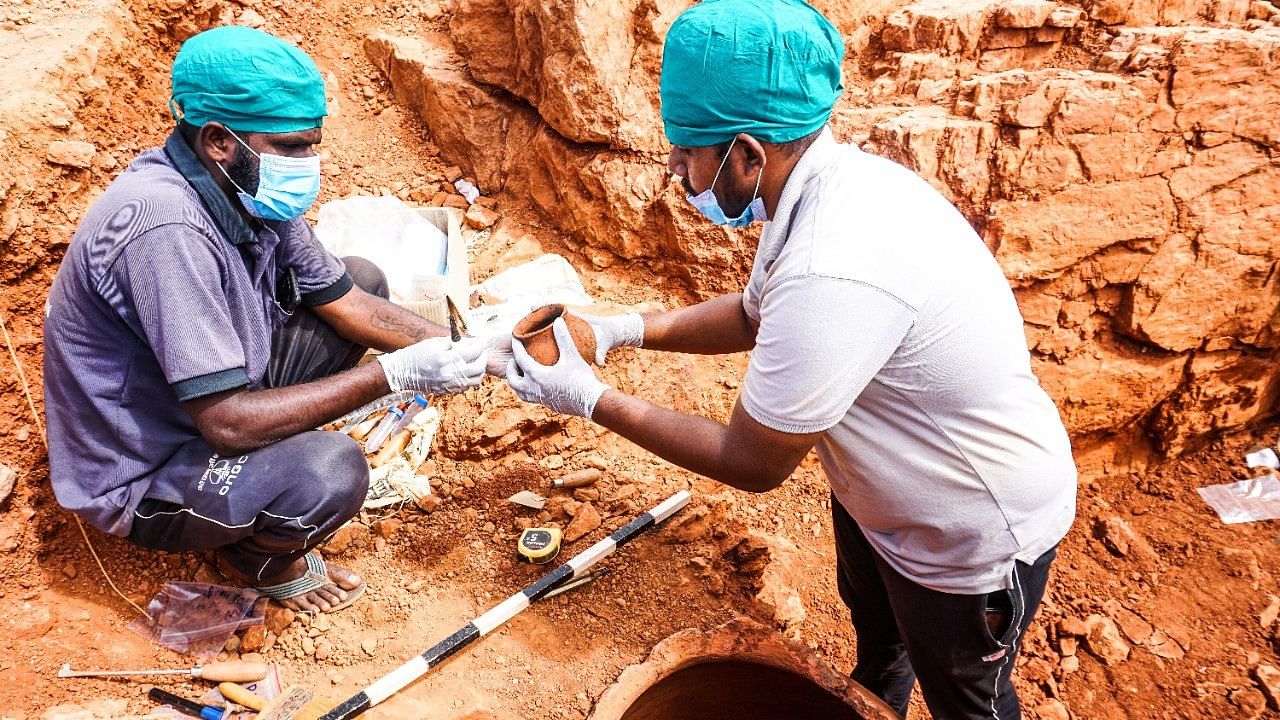
Keeladi archaeological excavation photos.
Credit: Tamil Nadu State Department of Archaeology
Chennai, DHNS: As part of his government’s efforts to “scientifically prove” that India’s history should be rewritten from the Tamil landscape, Tamil Nadu Chief Minister M K Stalin on Tuesday launched archaeological excavations in eight locations— four fresh sites and four existing sites like Sangam Era’s Keeladi and Kilnamandi of the megalithic period.
Excavations in all eight locations were approved by the Central Advisory Board for Archaeology (CABA) earlier this year, but the digging couldn’t take place immediately due to enforcement of the Model Code of Conduct that was in place for Lok Sabha polls.
“We still have a long way to go in filling in the cultural and chronological gaps in our glorious, and long history. Archaeological excavations are planned to cover all parts of Tamil Nadu to dig sites from prehistoric to historic periods to achieve the set goals,” a senior government official told DH.
Keeladi, the Sangam Era site 12 km south-east of Madurai is dated to be at least 2,600 years old with a thriving industrialised settlement on the banks of River Vaigai, Kilnamandi (Tiruvannamalai), Vembakottai (Virudhunagar), and Porpanai Kottai (Pudukkottai). These are the four existing sites where excavations will continue in different phases.
Chennanur in Krishnagiri district, Kongalnagaram (Tiruppur), Marungur (Cuddalore), and Thirumalpuram (Tenkasi), are the four new sites where the digging was launched by Chief Minister M K Stalin through videoconferencing from here.
While the archaeological excavation entered its 10th phase in Keeladi, it will be the third phase in Vembakottai, and second phase in Kilnamandi, and Porpanaikottai.
Archaeologists will work towards finding evidence of high tin bronze in Thirumalapuram, Iron Age in Marungur, and Neolithic Period in Chennanur.
The archaeological site in Thirumalapuram is spread over an area of about 25 acres and the excavation will help understand the nature of the site, determining the extent of the Palaeolithic burial site and identifying the Iron Age habitation area.
The archaeological mound in the historic village, Sennanur, is spread over an area of 50 acres and the digging will help find out whether humans have been continuously living in the region. Officials said the excavations in Sennanur will help decode the history of Krishnagiri district.
During the 2022-2023 season where digging was conducted in eight locations, nearly 10,000 antiquities, including terracotta figurines, glass beads, carnelian beads, iron tools, a tiger miniature made in bronze, gold, and punch-mark coins, were unearthed.
One of the significant findings last year was the discovery of 2,030 graffiti marks, including four with Tamil-Brahmi inscriptions, from Thulukkarpatti in Tirunelveli district. This assumes importance with the state government embarking on a comparative study of the graffiti marks, potsherds, and the Indus Valley Civilisation (IVC) signs.
The launch of excavations comes at a time the exercise has created a buzz in the past few years after they threw up surprises. Artefacts unearthed in Keeladi pushed the Sangam Era to 600 BCE from 300 BCE, rice husks found in a burial urn in Sivakalai was found to be 3,200 years old, and that Tamils were aware of iron technology in 2172 BCE, 4,200 years ago.
The carbon dating pushed the Sangam Era by three hundred years that it was thought to be. The Archeological Survey of India, which conducted the first two phases of excavation, also derived the period of the Sangam-era archaeological site to be between 8th century BCE to 3rd century CE.
These findings come amidst repeated assertions by Chief Minister M K Stalin that his government will take every step to scientifically prove that India’s history will have to be rewritten from the Tamil landscape, in the light of findings in Keeladi and Sivakalai.
Fresh scientific dates obtained through Accelerator Mass Spectrometry (AMS) dating of samples collected from archaeological sites excavated by the Tamil Nadu State Department of Archaeology (TNSDA) have pushed the origin of Tamili (Tamil-Brahmi) script by hundred years to 7th Century BCE.
Earlier this month, DH reported that of the 73 AMS dates obtained from Beta Analytic Laboratory, Florida, US after a detailed analyses into samples collected from excavation sites such as Kodumanal, Keeladi, Korkai, Alagankulam, Porunthal and Sivagalai, the earliest date arrived at is 685 BCE from Sivagalai in Thoothukudi district.